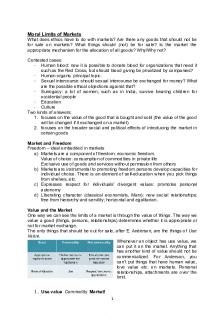Ch01-Sect06B Section 1.6 – Limits at Infinity PDF

| Title | Ch01-Sect06B Section 1.6 – Limits at Infinity |
|---|---|
| Course | Calculus I |
| Institution | University of Nevada, Las Vegas |
| Pages | 3 |
| File Size | 113.3 KB |
| File Type | |
| Total Downloads | 30 |
| Total Views | 194 |
Summary
Download Ch01-Sect06B Section 1.6 – Limits at Infinity PDF
Description
Chapter 1. Section 6 Page 1 of 3
Section 1.6 – Limits at Infinity Recall: , that is f (x ) =
p( x) . q (x )
•
You have already studied
•
You should already be able to identify the domain of this function, in other words, the values of x that are/are not allowed for inputs of f.
•
Q: How do we find any undefined points in the domain? A:
•
These points, if they are not , are called of the function there would tend to plus or minus infinity.
•
These types of infinite discontinuities are also called Example. For f ( x) =
. , and the limit .
1 What is the limit as x tends to 2 from the right? From the left? x−2
Horizontal Asymptotes: •
Think of an asymptote in general being an invisible line that a function ‘tends’ to if you were to keep drawing. You never quite get there.
•
For example, in the above function, the graph (as x tends to 2) gets closer and closer to the vertical line at x = 2 but never quite reaches it. And it will not cross over, either.
•
The above example function has another asymptote that is horizontal… If you were to let x get larger and larger ( x → ±∞ ) the function would get closer and closer to an ‘invisible’ horizontal line.
•
Q: What value does the function tend to as x → ±∞ ? What is the equation of this line? A:
.
C. Bellomo, revised 16-Aug-08
Chapter 1. Section 6 Page 2 of 3
Finding Horizontal Asymptotes: •
As we ‘extend’ the function to the left and right as far as we want, we are essentially taking the limit as x tends to plus and minus infinity.
•
To find the horizontal asymptote, if it exists, take the limit as x tends to plus and minus infinity.
•
HOW TO find horizontal asymptotes for rational functions f ( x) =
•
Example. Find lim
•
Example. Find lim
p( x) : q( x) 1. Find the leading term of the numerator, p(x) and denominator, q(x). 2. Write as a quotient and simplify. 3. If the reduction is – a constant, then this is the value of your horizontal asymptote. 1 ⎛ ⎞ – constant ⋅ ⎜ positive value ⎟ , then the horizontal asymptote is zero ⎝x ⎠ positive value – constant ⋅ (x ) , then there is no horizontal asymptote It will tend to plus or minus infinity (plug in to see which). 3 x2 + x +5 x→∞ x2 − 4
2 3 3x + x + 5 x →∞ 2 x 2 + x 4 − 4
C. Bellomo, revised 16-Aug-08
Chapter 1. Section 6 Page 3 of 3
3 x2 + x3 + 5 x→∞ 2 x2 − 4
•
Example. Find lim
•
Example. Find lim
x→−∞
2 x ( x −1)( x + 2) 3−x
C. Bellomo, revised 16-Aug-08...
Similar Free PDFs

Propuesta Infinity Music 201 6
- 8 Pages

IBC Notes Section 7 to 16
- 4 Pages

Know Your Limits Assignment
- 2 Pages

103 worksheet limits
- 4 Pages

Moral Limits of Markets
- 4 Pages

Lab Report Atterberg Limits
- 8 Pages

14.2 Limits And Continuity
- 4 Pages

1-Limits Student Notes 2021
- 34 Pages
Popular Institutions
- Tinajero National High School - Annex
- Politeknik Caltex Riau
- Yokohama City University
- SGT University
- University of Al-Qadisiyah
- Divine Word College of Vigan
- Techniek College Rotterdam
- Universidade de Santiago
- Universiti Teknologi MARA Cawangan Johor Kampus Pasir Gudang
- Poltekkes Kemenkes Yogyakarta
- Baguio City National High School
- Colegio san marcos
- preparatoria uno
- Centro de Bachillerato Tecnológico Industrial y de Servicios No. 107
- Dalian Maritime University
- Quang Trung Secondary School
- Colegio Tecnológico en Informática
- Corporación Regional de Educación Superior
- Grupo CEDVA
- Dar Al Uloom University
- Centro de Estudios Preuniversitarios de la Universidad Nacional de Ingeniería
- 上智大学
- Aakash International School, Nuna Majara
- San Felipe Neri Catholic School
- Kang Chiao International School - New Taipei City
- Misamis Occidental National High School
- Institución Educativa Escuela Normal Juan Ladrilleros
- Kolehiyo ng Pantukan
- Batanes State College
- Instituto Continental
- Sekolah Menengah Kejuruan Kesehatan Kaltara (Tarakan)
- Colegio de La Inmaculada Concepcion - Cebu







